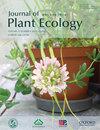Interspecific and intraspecific adaptations of pteridophyte leaf traits in limestone and non-limestone forests of monsoon tropical regions of southwest China
IF 3.9
2区 环境科学与生态学
Q2 ECOLOGY
引用次数: 0
Abstract
Plant species often show different taxonomic and functional characteristics between limestone forests (LFs) and non-limestone forests (NLFs) in tropical regions. Pteridophyte species are one of the major components in tropical rainforests; however, the morphological and physiological characteristics of pteridophytes occurring in LFs are poorly understood. We evaluated the differences in seven leaf functional traits between pteridophyte species in LFs and NLFs in southwest China. We measured leaf water content, morphological traits including leaf size, leaf thickness, stomatal length, and stomatal density, and physiological traits including stomatal conductance and photosynthetic rate from a total of 25 species. We found that pteridophytes had thicker and smaller leaves with lower stomatal density and lower stomatal conductance in LFs compared to NLFs, probably reflecting their adaptations in water use strategies. These differences, however, became non-significant when we accounted for phylogenetic relationships, suggesting that phylogenetic conservatism shapes trait differences and ultimately species composition in LFs and NLFs. Some species that were commonly found in both LFs and NLFs demonstrated intraspecific variation between forest types, with lower stomatal density in LFs. Our findings suggest that only a handful of pteridophyte species can adapt their water use strategies in both LFs and NLFs, and thus adaptative radiation is unlikely to have occurred.中国西南季风热带地区石灰岩和非石灰岩森林蕨类植物叶片性状的种间和种内适应
热带地区石灰岩森林和非石灰岩森林的植物物种往往表现出不同的分类和功能特征。蕨类植物是热带雨林的主要组成部分之一;然而,对LFs中蕨类植物的形态和生理特征了解甚少。研究了西南低海拔和低海拔地区蕨类植物7个叶片功能性状的差异。测定了25种植物叶片含水量、叶片大小、叶片厚度、气孔长度和气孔密度等形态性状以及气孔导度和光合速率等生理性状。研究发现,与非自然植被相比,低海拔植被的叶片更厚、更小,气孔密度和气孔导度也更低,这可能反映了它们对水分利用策略的适应。然而,当我们考虑到系统发育关系时,这些差异就变得不显著了,这表明系统发育保守性决定了LFs和nlf的性状差异,并最终决定了物种组成。一些常存于低林分和低林分的树种在不同林型间表现出种内差异,低林分的气孔密度较低。我们的研究结果表明,只有少数蕨类植物能够在低海拔和低海拔地区同时适应它们的水分利用策略,因此不太可能发生适应性辐射。
本文章由计算机程序翻译,如有差异,请以英文原文为准。
求助全文
约1分钟内获得全文
求助全文
来源期刊

Journal of Plant Ecology
生物-植物科学
CiteScore
4.60
自引率
18.50%
发文量
134
审稿时长
3 months
期刊介绍:
Journal of Plant Ecology (JPE) serves as an important medium for ecologists to present research findings and discuss challenging issues in the broad field of plants and their interactions with biotic and abiotic environment. The JPE will cover all aspects of plant ecology, including plant ecophysiology, population ecology, community ecology, ecosystem ecology and landscape ecology as well as conservation ecology, evolutionary ecology, and theoretical ecology.
 求助内容:
求助内容: 应助结果提醒方式:
应助结果提醒方式:


